Vagabonding in Asia 2009, part 1 of 11: Southeast China
|
Part 1 China, southeast |
Part 2 China, southwest |
Part 3 China, north |
Part 4 Tibet |
Part 5 Nepal |
Part 6 India, south |
|
Part 7 Malaysia |
Part 8 Sumatra and Java |
Part 9 Bali and Lombok |
Part 10 Australia |
Part 11 Laos, Cambodia, Bangkok |
Tour dates: 17 March - 17 May 2009.
Air travel is shown in blue; bus and train travel is shown in pink.
The starting point was Hong Kong.

|
Arrived in Hong Kong. Places are hard to find here - there are very few street signs, had to ask locals to find the hotel. To encourage me, there is a sign in the elevator saying that the hotel is illegal because the building is residential only. But who would want to live in such a tiny apartment? The travel agent down the street has a sign in the elevator that says "sterilization two hours". Do I really want toi be here?
Hong Kong looks like someone wanted to build Los Angeles but only had Kaliningrad to work with. There are the shiny skyscrapers, but most of the buildings and towers are slightly dilapidated chicken coops with fading paint and, judging by the floor space and symmetry, tiny apartments. Little air conditioning units grow on the sides like fungus. Hong Kong is large but not as large as you'd think with its population of 6.9 million.
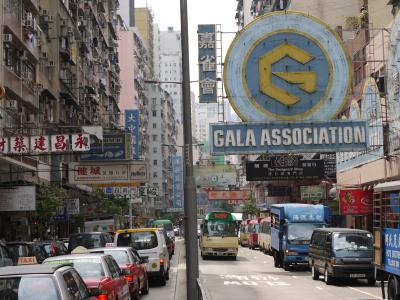
| 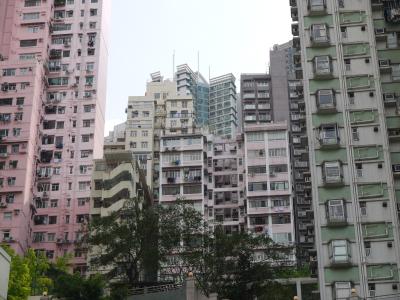
|
| Downtown Hong Kong street | Residential towers in Hong Kong |
There are 7-Eleven convenience stores everywhere. They don't have very much that one would want to buy. They do have Minute Maid orange juice whose list of ingredients includes "fish products". Yuck. Had good Dim Sum today in Sheung Wan, which is supposed to be something like a traditional downtown and actually has a few pleasant temples and gardens tucked away between those residential towers that make the skyline look a little like tooth decay.
Took the Star Ferry to Kowloon. You can cross the bay by train, but the old ferries are much more fun. While Hong Kong island, where I was staying, is a long thin half-moon of a city stretching along the bay waterfront, Kowloon is the peninsula across the bay. There is a Cultural Center with an old belltower surrounded by some rather uninspired architecture at the ferry landing, but with a fantastic view of the curved Hong Kong island skyline and the mountains behind it. There is a sign "beware of the pedestrians".
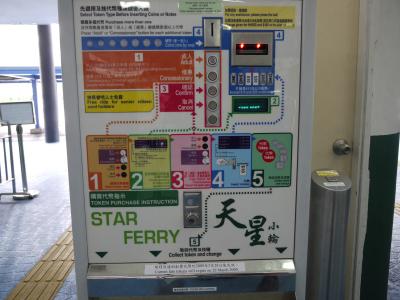
| 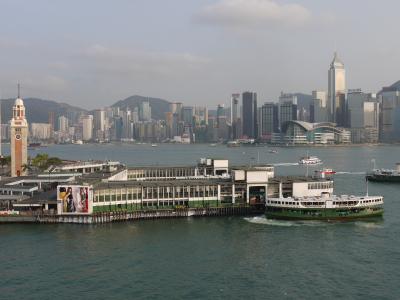
|
| Buying a Star Ferry ticket - easy. | Kowloon's ferry harbor |
Kowloon is much friendlier than Hong Kong island - the traffic isn't quite as murderous, the waterfront is accessible and not a tangle of freeways, they have trees and a very nice park with fragrant flower gardens, ponds with koi and turtles, a little hedge maze, flamingos, and an aviary. A great place to while away a few hours. The main shopping street is Nathan Road, lined with old trees. It has the same luxury chain stores as any other major shopping street on the planet. What the others don't have is sleazy operators every ten meters who whisper "copy watch?" in your ear. One was offering a "girl market".
I tried to get food at Knutsfort Terraces (Most street names are still British), a narrow street known for its restaurants, but it's mostly Italian places that sell pizza and "braised spaghetti". I can have that at home. I found a small Chinese restaurant not overrun with tour groups, but I am afraid I can get that better at home too... I like meat well-prepared, not by cutting an animals into ribbons and serving the shreds with skin, bone pieces, and tendons still hanging off of them.
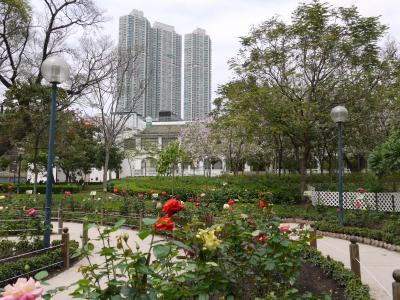
| 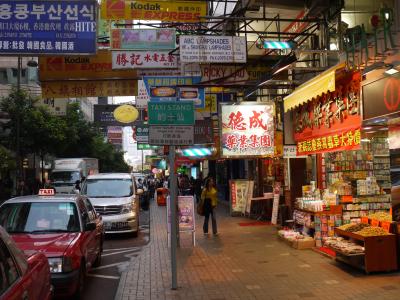
|
| Kowloon park | Shopping in Kowloon |
They drive on the wrong side in all of Hong Kong. But like other places where they drive on the left, there is no clear rule whether you walk on the left too, or on the right. I'd say 2/3 of the time they walk on the right. The up escalator or stairs marked "up" are sometimes on the left and sometimes on the right. I saw a large outdoor pool with lanes marked off with ropes, and everyone swam in nice orderly lines in each lane, like ants, to avoid colliding with oncoming traffic - and in about 2/3 of the many lanes, at random, people swam on the right... Weird.
Macau is an island 65km off of Hong Kong. Both are part of China. But in order to travel from one to the other, you have to go through an immigration procedure that requires a passport and entry and exit declarations. The immigration hall in Macau is very large and was packed with people; it took nearly an hour to get in. Oddly I was a head taller than almost everyone else there.
It's very strange to go through all this - mainland China, Macau, and Hong Kong are all part of China - but Macau and Hong Kong (among others) are "special economic zones" where many mainland Chinese rules do not apply, the economy is much more independent, and some people get very very rich. That makes it attractive to people, even though many stay very poor in Hong Kong, so China is regulating the borders. As a tourist, there is no problem, except that you need a visa that takes time to get for mainland China (but not Hong Kong or Macau).
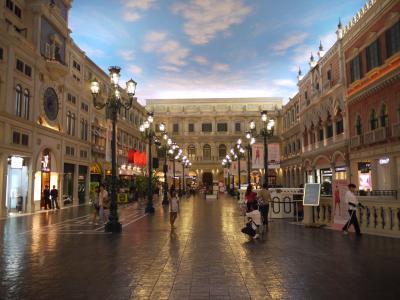
| 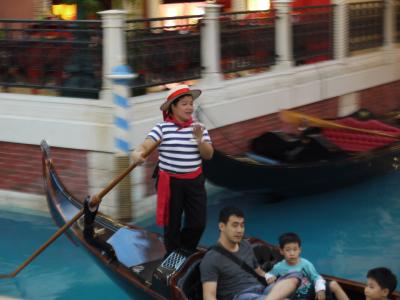
|
| Venetian casino in Macau | |
Gambling is legal in Macau, and only in Macau. So I took the shuttle bus to the Venetian Casino to see Venice first-hand, like a friend who was there a few weeks earlier (hi Martin). It's a giant mall with facades inspired by Venetian architecture, two Canals Grandes, lots of bridges, a copy of St. Marcus square, a campanile, the works, under a blue artificial sky. A little artistic freedom made the buildings all look like buildings in a mall, and the Canals Grandes were about four meters wide and smelled like chlorine instead of you know what. But they had gondolas and a Chinese gondoliere who belted out O Sole Mio at the top of her voice. This is shocking to Italians because a true Venetian gondoliere would never sing a Neapolitan song! It's all incredibly cheesy and bizarre and Las Vegas on steroids but you have to admire the effort.
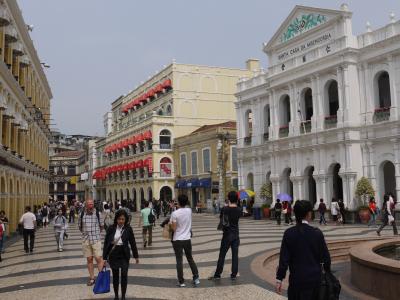
| 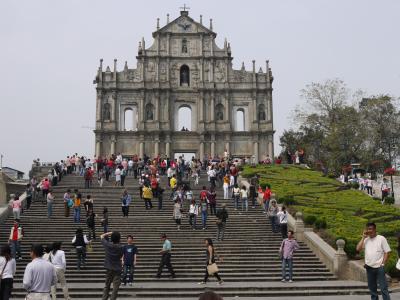
|
| Largo do Senado in Portuguese Macau | Landmark church facade in Portuguese Macau |
Ok, to the real Macau. It was a Portuguese colony and you can still see that. Around the main square, Largo do Senado, the colonial architecture was preserved perfectly, but it's packed with tourists, like the surrounding shopping streets. But walk a little further and there are little crooked alleys, only old buildings (all in desperate need of fresh paint), the characteristic tiny balconies that look like bird cages, little Chinese shops and people going about their work, and little traffic except along the few thoroughfares. Macau is wonderfully relaxing and enjoyable after Hong Kong and Kowloon. It seems that Macau was able to preserve its authenticity and its soul, apart from a few tourist watering holes. And the eastern edge of town, which is a loud and soulless modern town.
Portuguese egg tarts are extremely filling! Macau has its own currency, the pataca (MOP$), but it's pegged to the Hong Kong dollar which is universally accepted in Macau.
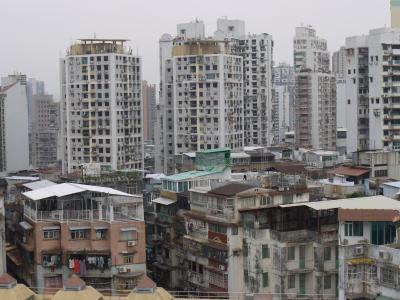
| 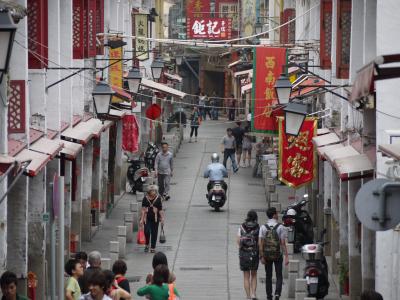
|
| Residential towers in Macau | Historic Chinese shops in Macau |
The main landmark of Macau is the church of St. Paul, built by Jesuits in the seventeenth century and burned down in the eighteenth, leaving only the front facade standing. It is quite ornate, and supported by steel scaffolding on the back. There is also an old fort next to it. I enjoyed Macau quite a bit, if I hadn't bought a ticket to Guangzhou and made a reservation there for the next day I might have stayed there overnight.
Using the express train to Guangzhou (a.k.a. Canton) is easy. Bags are x-rayed, visas are checked, and exit and entry cards are needed, but everything is much faster than the same procedures in Macau. At the station, the candy store sells palm-sized chocolate coins, but only ancient Chinese motifs and Dutch 2-Euro coins. The train was roomy and comfortable; the car attendant stood to attention as we boarded. The very slowly scrolling LED display in the car shows instructions for sneezing properly.
I was staying at the Elan hotel. Trendy, modern, clean, and bright, much better than the hotel in Hong Kong. WLAN too. Oddly, they want a deposit of 350 Yuan.
In Guangzhou, there is much less English. Street signs and the metro show English, but there was a lengthy notice in the train station in which the only English word was "notice" at the top (very helpful guys), and the long-distance bus terminal where I bought my ticket to Yangshuo for the next day had no English signage whatever and the ticket agents didn't speak English either. I got my ticket by pattern-matching the Chinese characters, and pronouncing "Yangshuo" until there was rapport. No problem.

| 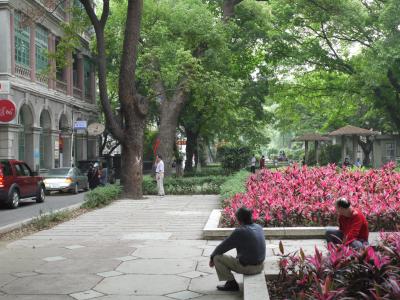
|
| Train station square in Guangzhou | Shamian district in Guangzhou |
Large sections of Guangzhou are ugly concrete and chipped paint and glass towers separated by a maelstrom of traffic and endless asphalt. So I went to Yuexio Park close to the hotel; the park is very large and contains hills, ponds, lots of banyan trees, a waterfall, flowers, and a few shrines. Very relaxing. I then took the underground to Shamian, a small island just beyond a tangle of freeways and highrise construction. Shamian is a quiet refuge of colonial charm, with lots of trees and a narrow park down the central avenue. In a country that bulldozes its own history in the name of modernization, Shamian's colonial architecture must take the role of a historical district.
Finally I walked for a few hours in the western part of Guangzhou, which is still untouched by rampant modernization and has shady tree-lined streets, old buildings, and traditional shops open to the street with people working.

|
The bus from Guangzhou to Yangshuo takes eight hours, but there is so much to see that it's never boring. All the long-distance buses are reasonably modern and comfortable, and unlike other buses I have used in Asia, quiet (both the engine and due to the absence of soap operas on the TV set). It makes three rest stops. Before one is allowed to enter the bus, the baggage gets x-rayed, as always, but not the carryons. If you carry weapons, take them with you on board to avoid hassle.
At first, the towns we passed through were all well-maintained sterile concrete affairs with wide boulevards with flower beds in the middle, without any sign of the seediness one can find in Guangzhou. A bit like Wolfsburg with flowers. But later on, towns look like Asian towns are supposed to look like - a little run down, busy, alive with merchants and cyclists and animals and shopkeepers going about their trade. The freeway is new, wide, and smooth, except in a few places where construction isn't finished. In one place we had to slow down at an accident site; police were standing around a body on the road that wasn't moving.
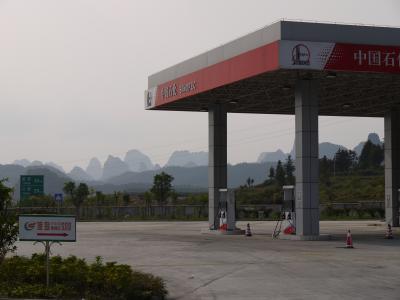
| 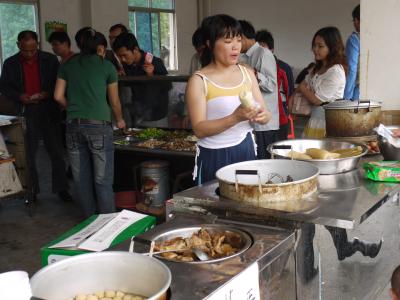
|
| Gas station on the way to Yangshuo | Food kitchen on the way to Yangshuo |
About an hour before reaching Yangshuo, the karst mountains begin. They consist of countless conical pillars of rock that form a violently jagged skyline all around the road. Yangshuo itself is nestled in between of several karst pillars. It's a busy little town that caters mainly to tourists, but manages to preserve its soul. The main street is Xi Jie, or "Western Street" as it confusingly shown on signs even though there is very little English signage in this town. It's a pedestrianized street lined with modern shops and restaurants, in old two-story or houses. It's sort of pleasant despite all the glowing ads and tourists. Virtually all the tourists are Chinese, I saw perhaps a dozen Westerners all evening.
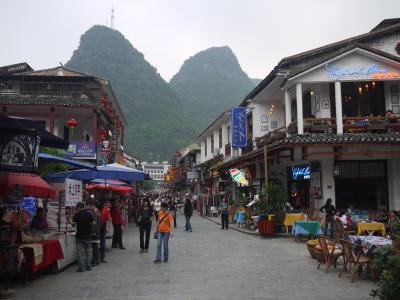
| 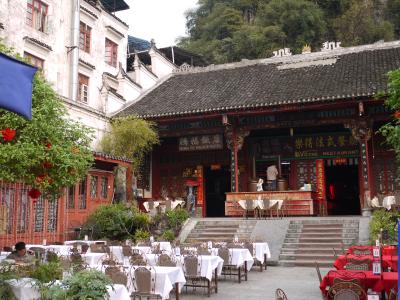
|
| Street in the old downtown of Yangshuo | Hongfu Palace Hotel in Yangshuo |
My hotel is the Hongfu Palace Hotel. The rooms are a little cheerless despite the wooden floors, stucco, and old furniture, but the building is in is a magnificent 400-year old guild hall. Most of the other hotels are either backpacker hostels or sterile Chinese tourist hotels. Chinese tourists love faceless white-tiled business hotels. As it's off-season, I haggled the price down to less than half the rack rate with little effort. But, no WLAN.
Monday, 23 March 2009
Took a local bus to Yang Di where I had reserved a private boat on the Li River. The boat is made from bamboo and the bamboo is made from plastic.
The scenery on the Li River is magical. It's slightly hazy, and we glide on the river between the huge overgrown stone pillars, forming a jagged skyline all around us. Some are in sunlight, others recede in the mist. There are few other boats, and when the motor is off, I can hear only the wind, the birds, and the voices of other boatmen echoing off the cliffs.
The scenery is so fantastic that it's shown on the 20 Yuan note, and my boatman's cigarette pack; he stopped in both locations to show me.
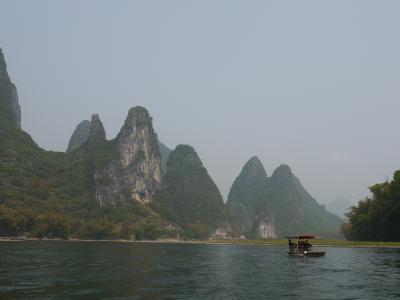
| 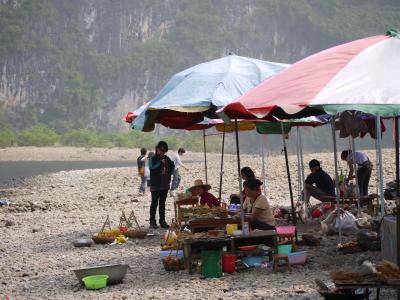
|
| Bamboo boating on the Li River | Food stalls on a bank in the Li River |
The water level is very low, so there are gravel banks along the shores and in the middle of the river. People have set up tents there and sell food, mostly crawly things with way too many legs on skewers.
After reaching Xing Ping, we took a minibus to the center of this smart little harbor village. I spent some time wandering about before returning to Yangshuo by bus. This was a grand day out!
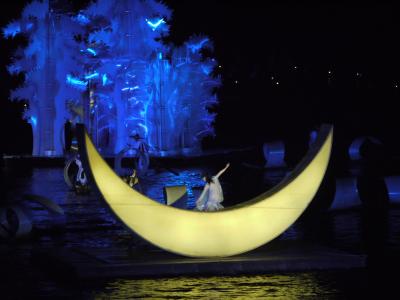
| 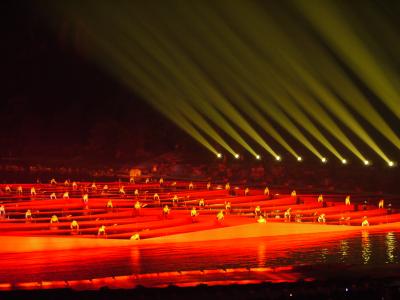
|
| Lake ballet in Yangshuo | |
At night I went to the Impressions Liu Sanjie, which is an enormous ballet of 600 actors that uses an entire lake and the mountains behind it. They use floats with little palaces on them that look like snowflakes, long floating platforms spanning the lake, lots of boats, long colored ribbons, and very sophisticated illumination. Dancers seem to walk on water, glitter, change color, while boats with lights were swirling around like fireflies. I had a good seat and got some surprisingly good pictures despite a handheld camera at full 400mm.
Tuesday, 24 March 2009
In the morning, I went out on a bicycle and with a guide, David Wong, the manager of the Hongfu Palace Hotel. He speaks English well. It took a while to find a bicycle that was large enough for me. David used an electric scooter because he was afraid that I'd outrun him, and in fact I did a few times because he was faster only uphill on smooth asphalt.
First we went to Moon Hill, a peak with a large crescent-shaped hole. I took a minivan ride up to Dragon Cave. The road is terrible and the van shook pitifully. Where other drivers keep car wash coins, mine kept a collection of rusty bolts. The cave is huge, with a long convoluted path cut through its many caverns. The first leg is by boat, with a ceiling so low that we had to duck low in the boat. Later some sections are under water too, with Indiana Jones bridges complete with broken logs (but at least they weren't suspended high up with ropes). The path was only a meter high in some places. My guides pointed out several dozen rock formations with flowery names like "dog rides golden lion". They knew all the places where I should take pictures and wouldn't continue until I did so. They spoke no English at all, and could only point at names on an English/Chinese map.
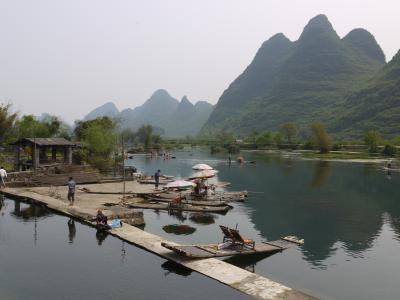
| 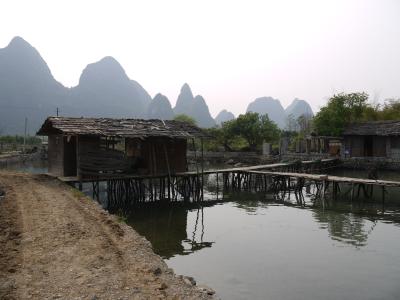
|
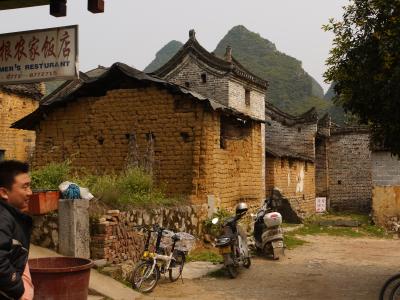
| 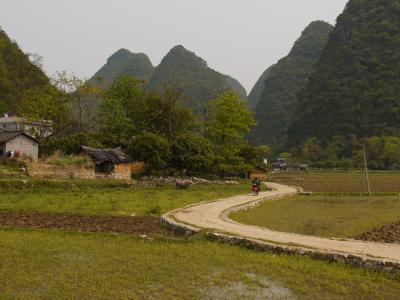
|
| Bicycle touring near Yangshuo | |
After returning from the cave, we continued by bicycle through the most marvelous scenery, through a valley of farm land, along Yulong River, surrounded by Yangshuo's trademark sugarcone peaks. The road quickly turned into a narrow trail through the fields and small villages, most of which cannot be reached by a regular road. Eventually we reached Jiuxian, a historic village that really looked like it hadn't been touched in centuries. We had excellent steamed fish there, caught the previous evening. The last stop was the Dragon bridge, an ancient stone arch in another old village. But what made this ride so fantastic was the scenery around us, not the monuments. The ride was about 45 km.
Took a local bus to Guilin, the other end of the usual Li River cruises. This town is totally different from Yangshuo - lots of traffic, asphalt, concrete, modern Chinese architecture that is supposed to impress but only manages to depress with its mindless rows of bland office buildings. They have narrow green strips along the rivers that escaped destruction. Maybe Guilin was once a nice town but no more. I went to the Seven Star Scenic Area, a tired park with a few monuments and low peaks.
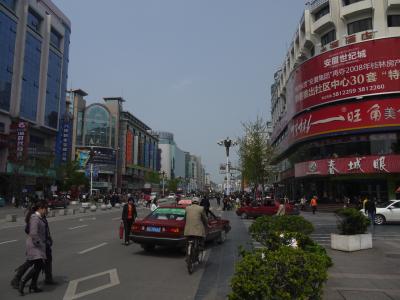
| 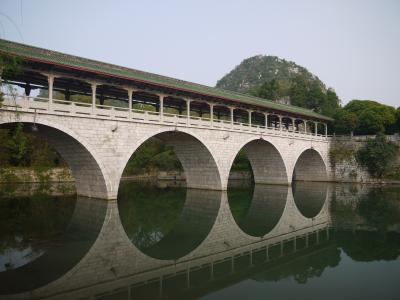
|
| Downtown Guilin | Covered bridge in Guilin's Seven Star Scenic Area |
I have deleted my flickr albums because I no longer trust US cloud services.
If you liked this report and
would like to read my exotic travel guide, click here.